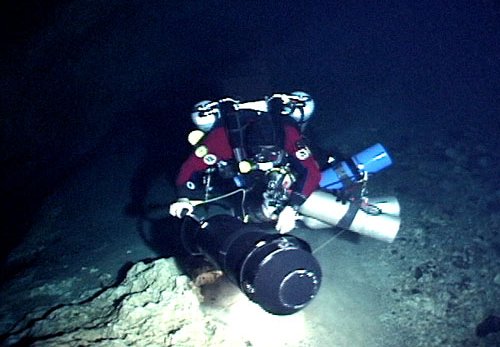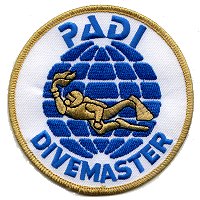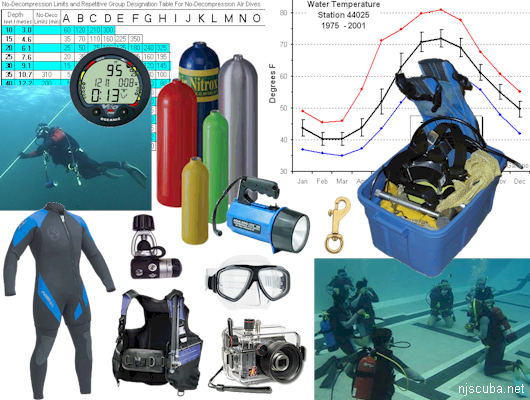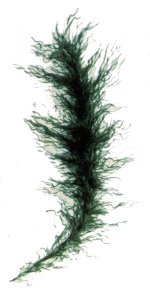Dive Training
So you’re thinking about trying scuba diving, but you’re not sure where to start. It is actually not difficult to get your entry-level certification to dive, easier than getting a driver’s license. Look in the Yellow Pages or in the Directories section of this website for a shop near you, or inquire at the local college, university, or YMCA, which may run classes that are open to the public.
- Gear Contents ...
- Dive Training ...
- Dive Gear ...
- Diving Activities ...
- Gas Calculators
- DPlan ...

You would have to be crazy to dive in the North Atlantic ( or anywhere ) and not protect yourself with inexpensive accident insurance coverage available from DAN - Diver's Alert Network. Check your existing health insurance policy, and you will most certainly find that accidents involving scuba diving are excluded ( skydiving too ).
DAN offers various packages, tailored to everyone from the most occasional Caribbean diver to the hard-core Andrea Doria techie. Coverage includes recompression chambers, transport, and other costs, both in and out of the country. The yearly fee for all this is not much more than the cost of a mask, or a single day's boat diving, and also includes membership in the organization and a subscription to their excellent safety-oriented magazine Alert Diver.
More: Insurance & Emergencies ...

"DIR" or "Doing It Right" is a system of diving developed by cave divers which involves extremely rigid gear configurations and methodologies. To its adherents, DIR takes on an almost religious significance. For the true follower of DIR, no deviation may be tolerated, because DIR is perfection.

DIR is designed for cave diving. The usual object of cave diving is to go in and come back out alive. In line with this goal of accomplishing essentially nothing, DIR espouses an absolutely minimal equipment kit: "When in doubt, leave it home." DIR also espouses teamwork, mutual interdependence, and close lock-step buddy diving, things that are pretty much unavoidable in the confines of a cave anyway.
More: Doing It Right? ...

Moving on to the professional level, the lowest professional rating is Divemaster. I would hardly recommend doing this unless you are really interested in turning Pro - Divemaster is the longest and most arduous rating of all to get. The Divemaster course is like graduate school - a year or more of indentured servitude. On the other hand, pitching in with classes and other activities can be a lot of fun. Divemasters are the sergeants and mules of the diving world and carry out much of the tour-guiding, tank-filling, and grunt work at resorts and on dive boats. Beyond Divemaster, there is Assistant Instructor, which is basically gold-plated Divemaster, and then increasing levels of Instructor.
More: Dive Training - Advanced ...
Here are a series of excellent articles regarding the buddy system, reproduced from their original sources before they "wink out", as so much good web content does. With regard to the Buddy System that is so entrenched in dive training, these articles are all negative. I feel no need to present counter-balancing positive arguments since you can get that from any dive instructor with any of the major certifying organizations.
When you first get certified, you will have had the buddy system drilled into you. At this point, you still have basically no idea what you are doing, so just do it that way. A lot of what is in the basic open-water certification is silly and even unnecessary, but it won't get you killed.
As a newly-certified diver, you are a danger to yourself and everyone around you. Be glad that any operator will take you out, and don't rock the boat. If they want you to dive with a buddy, dive with a buddy. As crew, I've spent numerous dives paired up with newbies to make sure they have a good time and get back to the boat OK. Shallow-water shore diving can get very tricky, and things can go very wrong, and if you are not experienced, having a buddy can be a lifesaver.
More: The Buddy System ? ...
An Explanation of Professor A.A. Buhlmann's ZH-L16 Algorithm
by Paul Chapman
Note to new divers and potential new divers:
This information is presented for general interest. Don't be scared off by what you see here - you don't need to learn any of this to become a safe and competent scuba diver. You will however need to understand dive planning.
The following is a summary of the decompression algorithm described by Dr A.A. Buhlmann in the fourth edition of his book Tauchmedizin ( diving medicine ) published in 1995 ( only in German. ) the book contains a considerable amount of other information and is published by Springer-Verlag ISBN 3-540-58970-8. Rumor has it that at the time of writing ( November 1999 ) an English translation is being prepared for publishing, so hopefully, in due course, this document will become redundant.
The algorithm is simply a "recipe" for modeling the behavior of inert gases, which diffuse in and out of our body tissues when breathed under varying pressures. The intention is that if the recipe models the actual processes in our bodies accurately enough, it can be used to plan dives ( and other pressure exposures ) with a view to avoiding decompression sickness.
More: Decompression Theory ...
Beneath the Waves

By Steve Nagiewicz & Herb Segars
Photography by Herb Segars
We have all watched television and marveled at the presentations of renowned underwater explorer Jacques Cousteau, or the movie fiction of Peter Benchley's "Jaws" or "The Deep." they have given us a glimpse into the strange underwater world that few of us get to explore. Yet how many of us have sat along the water's edge and wondered what mysteries must lie beneath the waves?
More: Why Dive in New Jersey? ...

- Home ...
- Dive Sites ...
- Artificial Reefs ...
- Marine Biology ...
More important than gear is training, and more important than training is experience. You can buy gear and training, but there is only one way to get experience.
In aviation there is a saying: "You start out with a full bag of luck, and an empty bag of experience. The trick is to fill up the bag of experience before the bag of luck runs out." The same is true for diving. Take it slow. As one of my instructors said: "There are old divers, and there are bold divers, but there are no old bold divers."
When you start out in this sport, buying your first set of dive gear can be bewildering, not to mention expensive. The sad truth is that as a newly-certified diver, the equipment you have seen and used so far is not what you should be buying for real-world use. Almost all of it - jacket-style BC, weight belt, light, snorkel, etc - is more suited to floating students in a swimming pool or quarry than real-world diving. Most scuba gear is designed for the mass market of easy, infrequent, warm water diving, and is inadequate and/or inappropriate for diving around here. With so many different models and variations of everything - how do you select the best equipment for you? In the absence of any other guide, your first impulse may be to go out and buy just the same gear you were trained in - which is almost certainly an expensive mistake.
More: Scuba Gear & Training ...

